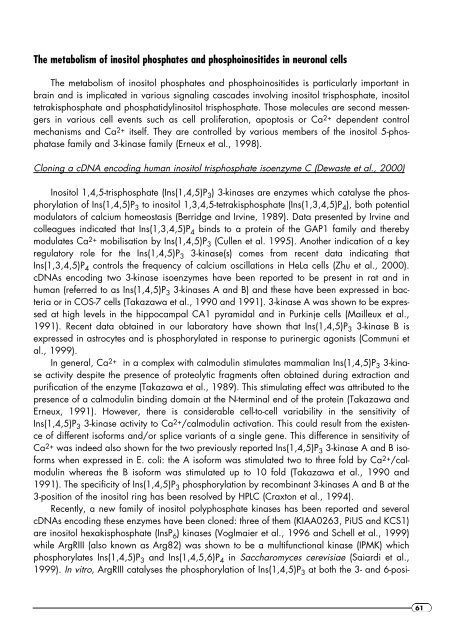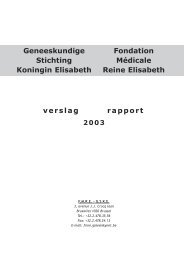Geneeskundige Stichting Koningin Elisabeth ... - GSKE - FMRE
Geneeskundige Stichting Koningin Elisabeth ... - GSKE - FMRE
Geneeskundige Stichting Koningin Elisabeth ... - GSKE - FMRE
You also want an ePaper? Increase the reach of your titles
YUMPU automatically turns print PDFs into web optimized ePapers that Google loves.
The metabolism of inositol phosphates and phosphoinositides in neuronal cells<br />
The metabolism of inositol phosphates and phosphoinositides is particularly important in<br />
brain and is implicated in various signaling cascades involving inositol trisphosphate, inositol<br />
tetrakisphosphate and phosphatidylinositol trisphosphate. Those molecules are second messengers<br />
in various cell events such as cell proliferation, apoptosis or Ca 2+ dependent control<br />
mechanisms and Ca 2+ itself. They are controlled by various members of the inositol 5-phosphatase<br />
family and 3-kinase family (Erneux et al., 1998).<br />
Cloning a cDNA encoding human inositol trisphosphate isoenzyme C (Dewaste et al., 2000)<br />
Inositol 1,4,5-trisphosphate (Ins(1,4,5)P 3) 3-kinases are enzymes which catalyse the phosphorylation<br />
of Ins(1,4,5)P 3 to inositol 1,3,4,5-tetrakisphosphate (Ins(1,3,4,5)P 4), both potential<br />
modulators of calcium homeostasis (Berridge and Irvine, 1989). Data presented by Irvine and<br />
colleagues indicated that Ins(1,3,4,5)P 4 binds to a protein of the GAP1 family and thereby<br />
modulates Ca 2+ mobilisation by Ins(1,4,5)P 3 (Cullen et al. 1995). Another indication of a key<br />
regulatory role for the Ins(1,4,5)P 3 3-kinase(s) comes from recent data indicating that<br />
Ins(1,3,4,5)P 4 controls the frequency of calcium oscillations in HeLa cells (Zhu et al., 2000).<br />
cDNAs encoding two 3-kinase isoenzymes have been reported to be present in rat and in<br />
human (referred to as Ins(1,4,5)P 3 3-kinases A and B) and these have been expressed in bacteria<br />
or in COS-7 cells (Takazawa et al., 1990 and 1991). 3-kinase A was shown to be expressed<br />
at high levels in the hippocampal CA1 pyramidal and in Purkinje cells (Mailleux et al.,<br />
1991). Recent data obtained in our laboratory have shown that Ins(1,4,5)P 3 3-kinase B is<br />
expressed in astrocytes and is phosphorylated in response to purinergic agonists (Communi et<br />
al., 1999).<br />
In general, Ca 2+ in a complex with calmodulin stimulates mammalian Ins(1,4,5)P 3 3-kinase<br />
activity despite the presence of proteolytic fragments often obtained during extraction and<br />
purification of the enzyme (Takazawa et al., 1989). This stimulating effect was attributed to the<br />
presence of a calmodulin binding domain at the N-terminal end of the protein (Takazawa and<br />
Erneux, 1991). However, there is considerable cell-to-cell variability in the sensitivity of<br />
Ins(1,4,5)P 3 3-kinase activity to Ca 2+/calmodulin activation. This could result from the existence<br />
of different isoforms and/or splice variants of a single gene. This difference in sensitivity of<br />
Ca 2+ was indeed also shown for the two previously reported Ins(1,4,5)P 3 3-kinase A and B isoforms<br />
when expressed in E. coli: the A isoform was stimulated two to three fold by Ca 2+/calmodulin<br />
whereas the B isoform was stimulated up to 10 fold (Takazawa et al., 1990 and<br />
1991). The specificity of Ins(1,4,5)P 3 phosphorylation by recombinant 3-kinases A and B at the<br />
3-position of the inositol ring has been resolved by HPLC (Craxton et al., 1994).<br />
Recently, a new family of inositol polyphosphate kinases has been reported and several<br />
cDNAs encoding these enzymes have been cloned: three of them (KIAA0263, PiUS and KCS1)<br />
are inositol hexakisphosphate (InsP 6) kinases (Voglmaier et al., 1996 and Schell et al., 1999)<br />
while ArgRIII (also known as Arg82) was shown to be a multifunctional kinase (IPMK) which<br />
phosphorylates Ins(1,4,5)P 3 and Ins(1,4,5,6)P 4 in Saccharomyces cerevisiae (Saiardi et al.,<br />
1999). In vitro, ArgRIII catalyses the phosphorylation of Ins(1,4,5)P 3 at both the 3- and 6-posi-<br />
61
















